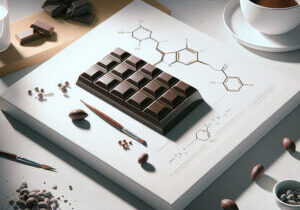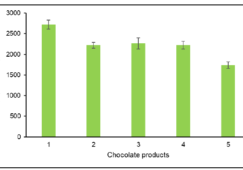BLOG
Polyphenol Content And Total Antioxidant Capacity Of 5 Brands Of Dark Chocolate Bar – a Scientific Study By Oxford Brookes Centre For Nutrition And Health
Are Raw Chocolate Bars Higher in Antioxidants and Polyphenols Compared to Traditional, Roasted Dark Chocolate Bars? An Objective, Scientific Study
We sent our dark raw chocolate, along with dark chocolate bars from 4 leading UK dark chocolate brands, to Oxford Brookes Centre of Nutrition and Health and asked them to analyse the dark chocolate bars for antioxidants and polyphenols.
Mr Popple’s hypothesis was that, as he does not roast the cacao he uses to make his chocolate bars, but instead keeps it raw / unroasted, there could be more antioxidants and polyphenols in Mr Popple’s raw dark chocolate bars compared to the other traditional dark chocolate bars made from roasted beans. This is because antioxidants and polyphenols are damaged and destroyed by heat.
In this article we have replaced the names of the other 4 leading UK dark chocolate brands with Brand B – Brand E, to protect their identities – and because we are not sure that these companies would like to be shown up by such a small artisan craft raw chocolate company as Mr Popple’s Chocolate! Rest assured that they are all very well known companies, all make excellent, tasty dark chocolate bars, and all of them are high quality, premium brands. We didn’t think it would be fair to compare the levels of antioxidants and polyphenols in our raw organic dark chocolate bars against cheap, low quality chocolate.
The TLDR of the Study – Which Dark Chocolate Bar has the Highest Levels of Antioxidants and Polyphenols?
A study was conducted to measure the beneficial compounds in different dark chocolate bars, focusing on polyphenols and antioxidants. Polyphenols are known for their protective properties in the body, while antioxidants help combat harmful substances called free radicals, which can cause damage to cells and tissues.
The study compared Mr Popple’s Chocolate to four other well-known dark chocolate brands – Brand B, Brand C, Brand D, and Brand E. The researchers measured the total polyphenol content, total antioxidant capacity, and the ability of each dark chocolate bar to neutralize free radicals.
The results revealed that Mr Popple’s Chocolate had the highest levels of polyphenols compared to all the other brands tested. Additionally, it demonstrated a greater antioxidant capacity and was more effective at combating free radicals than Brand B and Brand E dark chocolate bars. These findings suggest that Mr Popple’s Chocolate may offer more health benefits compared to some of the other dark chocolate bars included in the study.
For a full explanation of the study that follows, please view this layperson friendly guide to antioxidants and polyphenols in chocolate
The Full Chocolate Antioxidant and Polyphenol Study (Warning – Science Ahead!)
- INTRODUCTION
Antioxidants are known to protect tissues against damage caused by oxygen free radicals
and lipid peroxidation. Polyphenols are potent antioxidants but may also have beneficial
effects beyond antioxidant abilities such as involvement in cellular signalling, anti-inflammatory
properties1-3 and enhancing endothelial function.4 - METHODOLOGY
2.1 Protocol
All chemicals and reagents were of analytical grade and were purchased from Sigma-Aldrich
(Poole, UK). Five products (Mr Popple’s Chocolate, Brand B,
Brand C, Brand D and Brand E) were
provided by Mr Popple’s Chocolate Ltd. Extraction of each product was carried out in
triplicate using 70% acetone. Each extract was analysed in triplicate for total polyphenol
content, total antioxidant capacity and free radical scavenging activity.
2.1.1 Sample preparation and extraction
All products, were weighed (0.2 ± 0.01 g) and extracted with 4 mL of solvent (70% acetone)
for 2 hours at room temperature in a shaking water bath.5 The extracts were centrifuged at
3000 x g for 10 minutes using a benchtop centrifuge. The supernatant was removed and
immediately placed into a freezer at -20oC. This solvent extract was used for determining the
total polyphenol content, total antioxidant capacity and free radical scavenging activity.
2.1.2 Total polyphenol content
The total polyphenol content of the samples was determined using the Folin-Ciocalteau
method,6 a colorimetric assay based on the reduction of metal oxides in the Folin-Ciocalteau
reagent to produce a blue colour which can be detected by spectrophotometric assay. The
colour change is proportional to the concentration of polyphenols present in the extraction
mixture. The diluted (1:10) solvent extract was added to 1.5 mL of Folin-Ciocalteau reagent
(1:10, v/v with water) and allowed to equilibrate for 5 minutes. Then, 1.5mL sodium
carbonate solution (60g/L) was added and the tubes allowed to incubate in the dark at room
temperature for 90 minutes. The absorbance of the mixture was read at 725 nm, using the
extraction solvent (70% acetone) as a blank. The results were expressed as mg gallic acid
equivalents (GAE) per 100 gram of original chocolate samples.
2.1.3 Ferric-ion reducing antioxidant power (FRAP) assay
The total antioxidant capacity (TAC) of the samples was determined using a modification of
the FRAP assay of Benzie and Strain (1996).7 FRAP uses antioxidants as reductants in a
redox reaction that induces a colour change in an oxidant system. Ferric 4,6-tripyridyl-striazine
(Fe III TPTZ) at low pH can be reduced to ferrous form inducing a colour change
which can be monitored by spectrophotometric absorption. The reaction is non-specific in
that any half reaction with a lower redox potential will drive the ferric to ferrous (Fe II to Fe III)
ion formation under the reaction conditions. Therefore, the change in absorbance is related
directly to the ‘total’ reducing power of the electron donating antioxidants in the reaction
mixture and is not specific to polyphenols.
The FRAP reagent was prepared by mixing 300 mM acetate buffer (pH 3.6), 20 mM ferric
chloride and 10 mM 4,6-tripyridyl-s-triazine (TPTZ) made up in 40 mM hydrochloric acid in
the ratio 10:1:1. The FRAP assay was performed by incubating a blank/standard/diluted
(1:10) sample and FRAP reagent at 37oC for 4 minutes. The absorbance at 593 nm was
determined relative to the reagent blank. The TAC was determined against a standard of
ferrous sulphate with a known FRAP value (1000μM). The results were expressed as FRAP
values in mmol per 100 gram of original chocolate samples.
2.1.4 Free radical scavenging activity (DPPH inhibition assay)
Antioxidant activities of the extracts were determined using a modification of the Brand-
Williams et al. (1995) method.8 The DPPH (2,2-diphenyl-1-picrylhydrazyl) inhibition assay is
a measure of free radical scavenging activity. DPPH is a radical which has been used to
investigate the free radical scavenging ability of antioxidants present in foods and
beverages.6,9 The radical is an intense purple colour which turns colourless as antioxidants
sequester the unpaired electrons. 0.1 mL of the solvent extract was incubated with 3.9 mL of
50μM DPPH (prepared in methanol) at 37oC in a water bath for 30 minutes. After incubation,
absorbance was measured at 517 nm. The percentage inhibition of the test samples was
calculated against the control (extraction solvent) and ascorbic acid (1mM) standard.
2.2 Statistical Analyses
Data were analysed using the IBM Statistical Package for the Social Sciences (SPSS)
version 25.0 (SPSS Inc., Chicago, Illinois). Data are presented as mean and standard
deviation (SD) values. Prior to statistical analysis, the normality of the data was tested using
the Shapiro-Wilks statistic. The results for total polyphenol content were normally distributed.
Therefore, a one-way ANOVA test followed by a post hoc Tukey test was used to compare
the results. Statistical significance was set at P <0.05. As the results for at least one of the
samples under FRAP analysis and DPPH inhibition assay were not normally distributed, the
non-parametric Kruskal-Wallis test was used to compare total antioxidant capacity and of
DPPH inhibition (%) between the products. Where there was an overall statistically
significant difference at P<0.05, pair-wise comparisons were done with a Bonferroni
correction. P values with four or more decimal places are represented as P <0.001. - RESULTS
Table 1 presents the mean polyphenol content, total antioxidant capacity and free radical
scavenging activity of the samples. There was an overall significant difference between the
chocolate products in total polyphenol content, total antioxidant capacity and DPPH inhibition
(P<0.001).
| Chocolate Products | Polyphenol content (mg GAE/100g) | FRAP value (mmol/100g) | DPPH inhibition (%) |
| Mr Popple’s Chocolate | 2718.05 ± 110.74 | 5143.97 ± 647.43 | 88.93 ± 0.33 |
| Brand B | 2220.29 ± 74.60 | 3938.36 ± 227.40 | 87.78 ± 0.57 |
| Brand C | 2267.64 ± 135.62 | 3936.99 ± 450.01 | 87.79 ± 0.28 |
| Brand D | 2221.17 ± 92.80 | 4659.27 ± 488.06 | 89.06 ± 0.45 |
| Brand E | 1740.33 ± 82.16 | 2934.35 ± 293.91 | 87.14 ± 0.63 |
| P value | <0.001* | <0.001* | <0.001* |
five chocolate products (mean ± SD)
Fig 1 illustrates the polyphenol content of the five chocolate products. The results of pairwise
comparisons between the products are shown in Table 2.

Fig 1 Total polyphenol content of the five chocolate products. GAE Gallic acid equivalent
(1 – Mr Popple’s Chocolate, 2 – Brand B, 3 – Brand C
, 4 – Brand D and 5 – Brand E)
Table 2 Mean difference (%) in total polyphenol content along with P-values from pair-wise
comparisons between the chocolate products
| Brand B | Brand C | Brand D | Brand E | |
| Mr Popple’s Chocolate | 18% <0.001 | 17% <0.001 | 18% <0.001 | 36% <0.001 |
| Brand B | 2% 0.859 | 0% 1.000 | 22% <0.001 | |
| Brand C | 2% 0.867 | 23% <0.001 | ||
| Brand D | 22% <0.001 |
Fig 2 illustrates the total antioxidant capacity of the five chocolate products. The results of
pairwise comparisons between the products are shown in Table 3.

Fig 2 Total antioxidant capacity of the five chocolate products. FRAP – Ferric reducing
antioxidant power
Table 3 Mean difference (%) in total antioxidant capacity along with P-values from pairwise
comparisons between the chocolate products
| Brand B | Brand C | Brand D | Brand E | |
| Mr Popple’s Chocolate | 23% 0.016 | 23% 0.054 | 9% 1.000 | 43% <0.001 |
| Brand B | 0% 1.000 | 18% 0.206 | 25% 0.299 | |
| Brand C | 18% 0.526 | 25% 0.108 | ||
| Brand D | 37% <0.001 |
Fig 3 illustrates the DPPH inhibition (%) of the five chocolate products. The results of
pairwise comparisons between the chocolate products are shown in Table 4.

Fig 3 DPPH inhibition (%) of the five chocolate products. DPPH – 2,2-diphenyl-1-
picrylhydrazyl
Table 4 Mean difference (%) in DPPH inhibition along with P-values from pair-wise
comparisons between the chocolate products
| Brand B | Brand C | Brand D | Brand E | |
| Mr Popple’s Chocolate | 1% 0.025 | 1% 0.130 | 0% 1.000 | 2% <0.001 |
| Brand B | 0% 1.000 | 1% 0.014 | 1% 1.000 | |
| Brand C | 1% 0.082 | 1% 0.441 | ||
| Brand D | 2% <0.001 |
Summary of findings
The total polyphenol content of Mr Popple’s Chocolate was significantly higher
than the other brands tested. The total antioxidant capacity and the free radical scavenging activity
of Mr Popple’s Chocolate were significantly higher than Brand B and Brand E
REFERENCES
1 Williams RJ, Spencer JPE and Rice-Evans C (2004) Flavanoids: antioxidants or signalling
molecules? Free Radical Biology and Medicine 36: 838-849
2 Sies H, Schewe T, Heiss C and Kelm M (2005) Cocoa polyphenols and inflammatory mediators.
American Journal of Clinical Nutrition 81: 304S-312S
3 Ramos S (2008) Cancer chemoprevention and chemotherapy: dietary polyphenols and signalling
pathways. Molecular Nutrition & Food Research 52: 507-526
4 Caton PW, Pothecary MR, Lees DM, Khan NQ, Wood EG, Shoji T, Kanda T, Rull G and Corder R
(2010) Regulation of vascular endothelial function by procyanidin-rich foods and beverages.
Journal of Agriculture and Food Chemistry 58: 4008-4113
5 Thondre PS, Ryan L and Henry CJK (2011) Barley beta-glucan as rich sources of polyphenols
and antioxidants. Food Chemistry 126: 72-77
6 Sharma P, Gujral HS (2010) Antioxidant and polyphenol oxidase activity of germinated barley and
its milling fractions. Food Chemistry 120: 673–678.
7 Benzie IFF and Strain JJ (1996) The ferric reducing ability of plasma (FRAP) as a measure of
‘antioxidant power’: the FRAP assay. Analytical Biochemistry 239: 70–76
8 Brand-Williams W, Cuvelier ME and Berset C (1995) Use of a free radical method to evaluate
antioxidant activity. Lebensmittel Wissenschaft and Technologie 28: 25–30
9 Ryan L and Prescott SL (2010) Stability of the antioxidant capacity of twenty five commercially
available fruit juices subjected to an in vitro digestion. International Journal of Food Science and
Technology 45: 1191-1197








